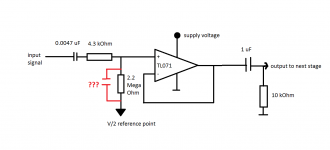Hello!
I'm building something like a guitar preamp.. I mean.. It is actually the input buffer for a guitar effects unit and it does not provide any gain.. its purpose is to ensure the minimum loading of the pickups possible. The 0.0047uF decoupling cap provides low frequency roll-off, but i thought that high frequency attenuation is needed as well for 2 reasons: first, the narrower the bandwidth, the lower the thermal noise, and since it is a distortion pedal with about 50 dB of gain, I believe this should not be neglected; second - a guitar is a sensitive device and it tends to pick up any kinds of EMI, so a low-pass filter should bring an improvement. However, I'm not sure how exactly to realize that low-pass filter without sacrifising the large input impedance. I am using an op-amp in a non-inverting configuration, so a cap in the feedback loop is not an option (it would reduce the gain at HF to 1, but the gain is already 1, since we have a follower). Another option I thought of is putting a small shunt cap (in the pF range) across the bias resistor, but i'm not sure if that is reasonable, since it may introduce distortion, and, more importantly, instability. I am really facing a challenge with this low-pass filter. Would you please give your ideas and opinions on what i can do or what is best to do and why? I'd be grateful. Thanks in advance.
I'm building something like a guitar preamp.. I mean.. It is actually the input buffer for a guitar effects unit and it does not provide any gain.. its purpose is to ensure the minimum loading of the pickups possible. The 0.0047uF decoupling cap provides low frequency roll-off, but i thought that high frequency attenuation is needed as well for 2 reasons: first, the narrower the bandwidth, the lower the thermal noise, and since it is a distortion pedal with about 50 dB of gain, I believe this should not be neglected; second - a guitar is a sensitive device and it tends to pick up any kinds of EMI, so a low-pass filter should bring an improvement. However, I'm not sure how exactly to realize that low-pass filter without sacrifising the large input impedance. I am using an op-amp in a non-inverting configuration, so a cap in the feedback loop is not an option (it would reduce the gain at HF to 1, but the gain is already 1, since we have a follower). Another option I thought of is putting a small shunt cap (in the pF range) across the bias resistor, but i'm not sure if that is reasonable, since it may introduce distortion, and, more importantly, instability. I am really facing a challenge with this low-pass filter. Would you please give your ideas and opinions on what i can do or what is best to do and why? I'd be grateful. Thanks in advance.
Attachments
Why not simulate it in LTSpice untill you get the response you would like (and not tell us about!) E
A small cap across the resistor should be fine. Make sure it has very short leads to keep self-inductance low. It forms a CR low pass filter with the 4.3k resistor, and will keep RF out. It won't reduce noise generated within the op-amp but, depending on the souce impedance, it may reduce HF thermal noise from the 2.2M resistor.
- Status
- Not open for further replies.
